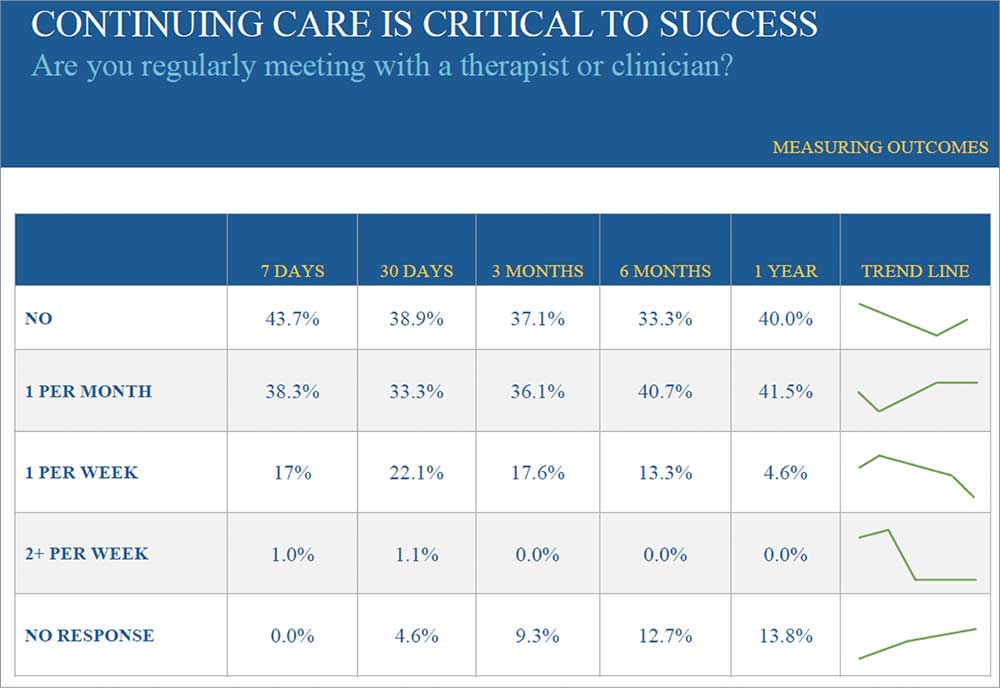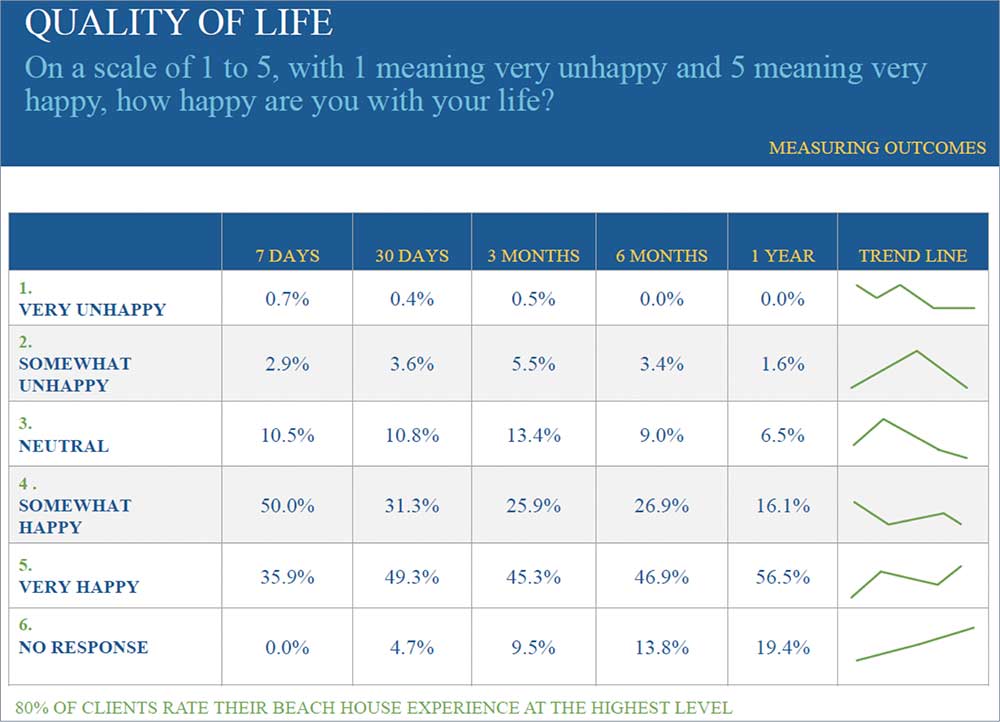In our mission to help every person who comes through our doors find lasting freedom from drugs and alcohol, we place a high premium on client treatment outcomes. In accordance with the latest research into these benchmarks for successful recovery, our center employs a client-directed, outcome-informed approach. We also routinely monitor, track, evaluate and continually seek to improve client outcomes in our drug and alcohol programs. And, because of our strong commitment to evidence-based clinical research and practices, we routinely encourage regular oversight and evaluation of our treatment process and outcomes by an independent third party.
Along with a description of our client-directed, outcome-informed approach, this section will present current data into Beach House treatment outcomes, based on our ongoing efforts to quantify, assess and improve these benchmarks of success in recovery on behalf of our clients.
Our Client-Directed, Outcome-Informed Approach (CDOI)
Our drug and alcohol treatment programs are distinguished by a client-directed, outcome-informed approach. The CDOI approach is inspired by the latest addiction research into the best predictors of positive treatment outcomes, and is characterized by at least five key components (Proctor and Herschman, 2015):
- A strong emphasis on “therapeutic alliance“
- Evidence-based therapies for treating addiction
- Evidence-based measurement tools for tracking outcomes
- Weekly clinical supervision of individual therapy sessions
- Regular third-party evaluation of treatment process and outcomes
- Therapeutic alliance
- Client-Directed, Outcomes-Informed approach
- Outcomes tracking
- Clinical supervision
- Multidisciplinary team meetings
- Family program
Each of these components is critical to helping us fulfill the sacred pledge we make to every client: a free and sober life grounded in people, purpose and passion. For more on how we go about integrating each of these components in our drug and alcohol programs, as well as the research that inspires this approach, check out our Clinical Excellence Practices.
How Beach House Treatment Outcomes Compare to Our Competitors’
Beach House has distinguished itself both nationally and closer to home on the basis of its rigorous commitment to measuring, tracking and continually seeking to improve our treatment outcomes. When we invited an independent third party, Map Health Management, to conduct a post-treatment, follow-up survey of 700 Beach House clients, we wanted to know how our clients were doing post-treatment when compared with clients from other treatment centers nationwide.


Discover what’s priceless—a future free of addiction, starting today:
Specifically, we wanted to know whether our clients were staying sober or whether they had gone back to drugs or alcohol. What, we wondered, were our clients’ rates of relapse, and how did these stack up next to those for other treatment centers?
We also wanted to know whether, following treatment, our clients were in full-time school or were employed during the past month, since these factors, too, are evidence-based benchmarks for success in recovery.
Here is what we found:
- 95% of Beach House clients were not using at the end of the month, compared to 76% that, after leaving other treatment centers, were not using.
- The flip side of this finding was that 5% of our clients had returned to using drugs and alcohol— (this as opposed to 24% who, following treatment at other facilities, relapsed).
- 62% of Beach House clients were either full-time in school or employed during the last month, compared to only 49% from other treatment centers.
In other words, the conclusion of an independent third party was that according to the above empirical measures of progress in recovery, Beach House treatment outcomes outrank those of other competitors in the field.
High Rates of Client Retention in Treatment
Beach House clients also enjoyed higher rates of retention in treatment—another indicator of success in recovery that can be empirically measured (Office of National Drug Control Policy, 1996). 67% of our clients, in fact, said they met with a therapist within seven days of discharge. That level of follow-through with a plan of continuing care is unprecedented in the addiction treatment world.


When we followed up with the same client alumni at regular intervals across the span of one full year following their treatment with us, we found that even at the one-year mark, 41.5% were still meeting at least once monthly with a therapist. Those high rates of retention, which we are continually seeking to improve, are encouraging benchmarks of our clients’ success in recovery.
Quality-of-Life and Client Satisfaction Measures
Client perceptions of their treatment experience, or satisfaction with the substance abuse care they receive, are another helpful measure of treatment outcome. So are client assessments of quality of life after treatment (Laudet, 2011). (Such measures have been used in independent clinical trials to gauge treatment outcomes for various addiction interventions.)
Strikingly, when our clients were asked to rate their quality of life one year following treatment with us, a clear majority (56.5%) described themselves as “very happy.” Moreover, 80% of our clients rated their Beach House experience at the highest level, with over 90% saying they would recommend Beach House to a friend or family member.

